Education
Briefing: four looming problems in the UK asylum system and how to address them
[ad_1]
The asylum system seems finally to have turned a corner: the asylum backlog is starting to fall.
The backlog is the single most important problem with the asylum system. Unlike arrivals, it is something the government can control. It creates huge financial costs for the taxpayer. It sucks money out of the international aid budget. It distracts ministers and officials from other issues. The thought of asylum seekers staying in hotels is politically toxic. It is also terrible for the refugees waiting interminably for a decision. Their lives are on hold, they live in destitution-level support in poor accommodation and they are prevented from working or doing anything productive. Eventually 75% will be recognised as refugees and become permanent members of our society. Making their lives so miserable and difficult rather than helping them get on their feet is not a good idea for any of us. And, as we will see, barely anyone who is refused asylum is removed from the UK anyway.
The only group to benefit from the long waiting times are those whose cases will ultimately fail; by the time that happens they will have been living here for years and it will be even harder for the government to remove than would otherwise have been the case.
In this briefing we will take a look at what is really going on with the main features of the contemporary asylum system: arrivals, the backlog, detention, removal and resettlement. The focus is on what caused the backlog and what consequences will flow from the massive increase in the number of positive and negative decisions we’re now seeing. The information is drawn mainly from the quarterly immigration statistics and transparency data for the year ended September 2023, the most recent available at the time of writing.
The picture the data presents is of a system that has been overwhelmed. Not by new arrivals but by mismanagement.
Asylum arrivals
Following a significant peak in 2002, the number of asylum applications made in the United Kingdom was fairly stable between 2005 and 2020. The Syrian refugee crisis beginning in 2014 caused a slight rise in overall numbers.
The number of asylum applications increased significantly in 2021 and again in 2022, however. This was largely due to increasing numbers of arrival by means of small boats.
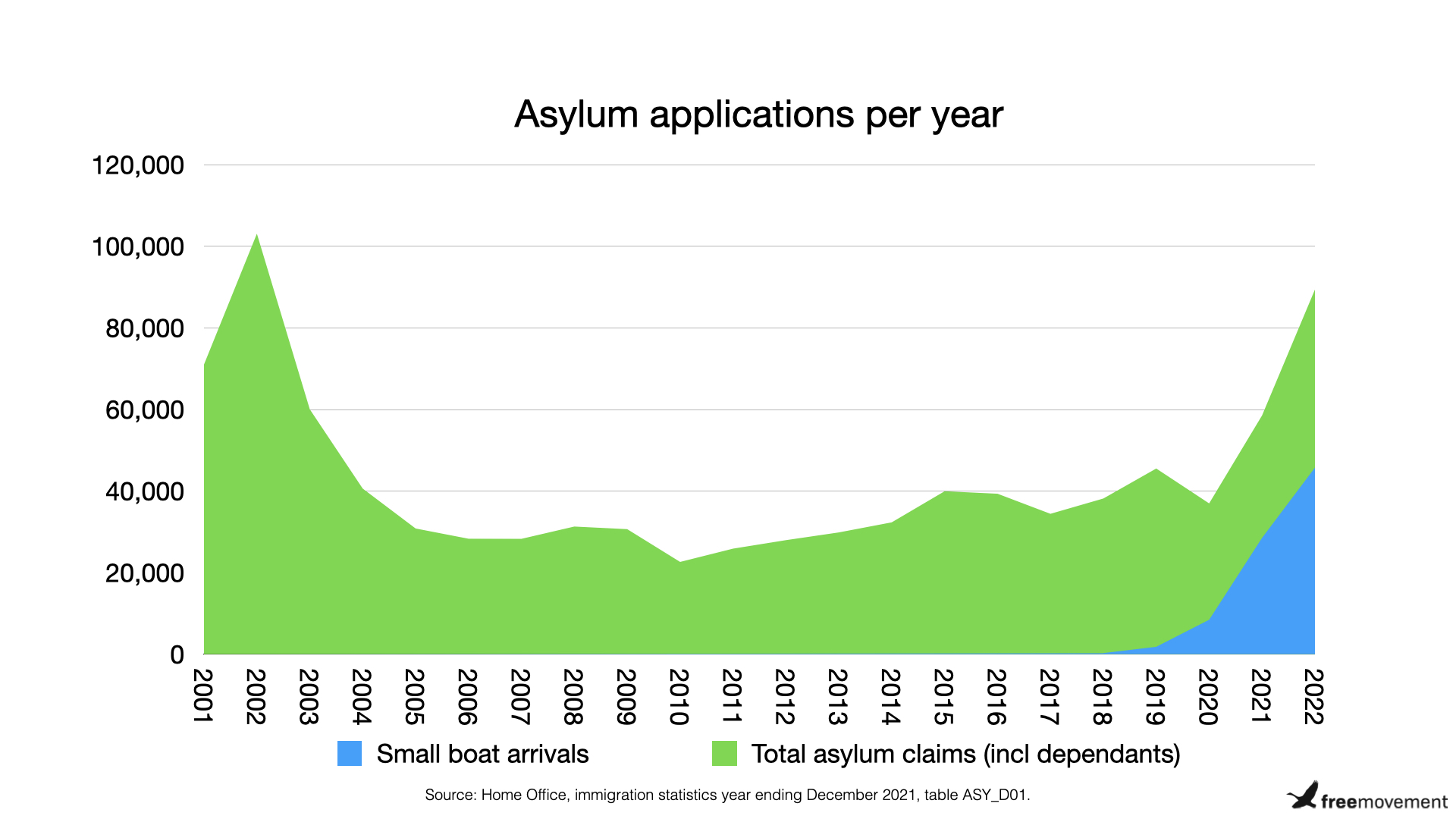
The shrinking area of green for 2020 and 2021 on the chart reflects the fact that the increase in small boat arrivals in large part represented a change of route by asylum seekers. Previously, lorries had been the principal means of entry to claim asylum.
The number of small boat arrivals can be seen to have increased sharply from nowhere in 2018. The following chart shows overall numbers and also gives you an idea of arrivals by quarter. You can see that arrivals in 2023 are actually down a little compared to 2022.
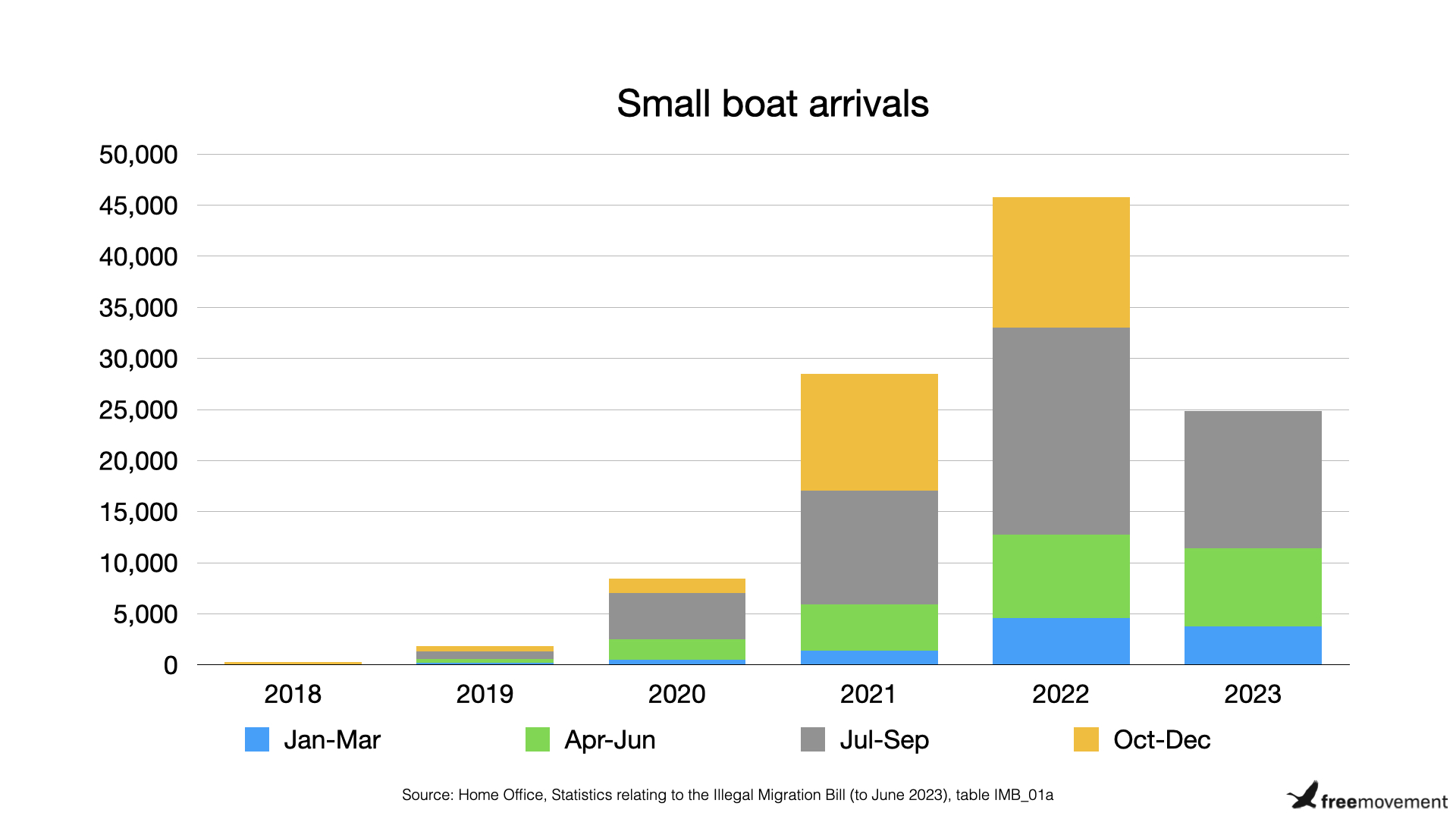
The overall drop in 2023 compared to 2022 is entirely due to the rapid increase and then equally rapid decrease in arrivals by Albanians during 2022. In effect, this inflated the 2022 figures quite considerably. If Albanians are stripped out of the figures, the number of small boat arrivals is actually up in 2023 compared to 2022; in other words, there has continued to be an increase in the arrival of those of nationalities other than Albanians.
The top nationality entering by small boat in 2023 so far is by far and away Afghans. Albanians barely even make the top ten.
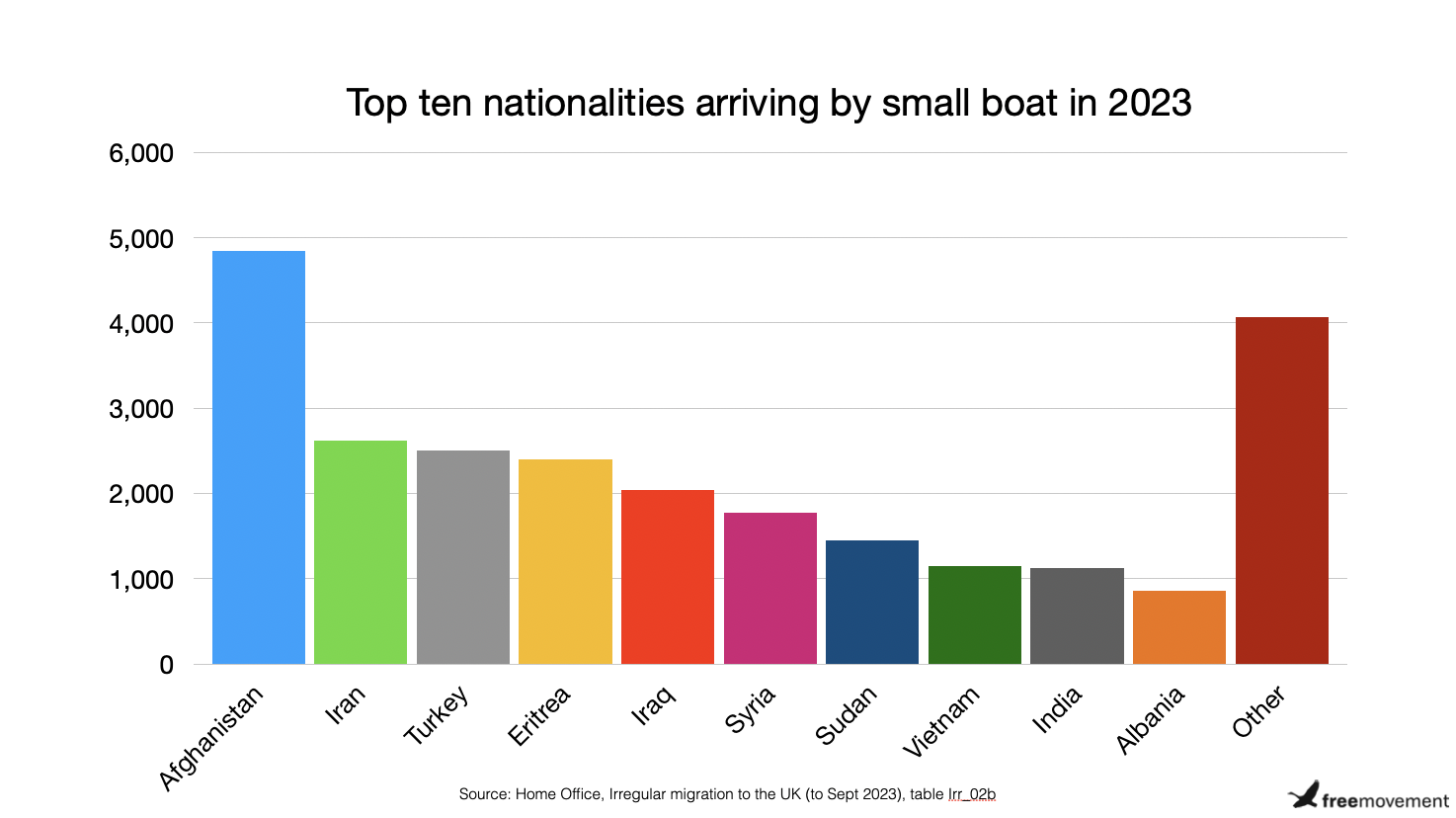
Asylum backlog
The stand out problem of the asylum system today is the time it takes for decisions to be made. This is a recent development. Unlike small boat arrivals, it lies entirely within the control of the Home Office. The good news is that the backlog has started, finally, to stabilise. It has even started to fall a little.
Asylum backlog starts to stabilise and fall
If we plot arrivals against backlog and decisions we can see that the growth in the backlog, which really begins in the middle of 2018, considerably pre-dates the steep increase in arrivals in 2021 and 2022.
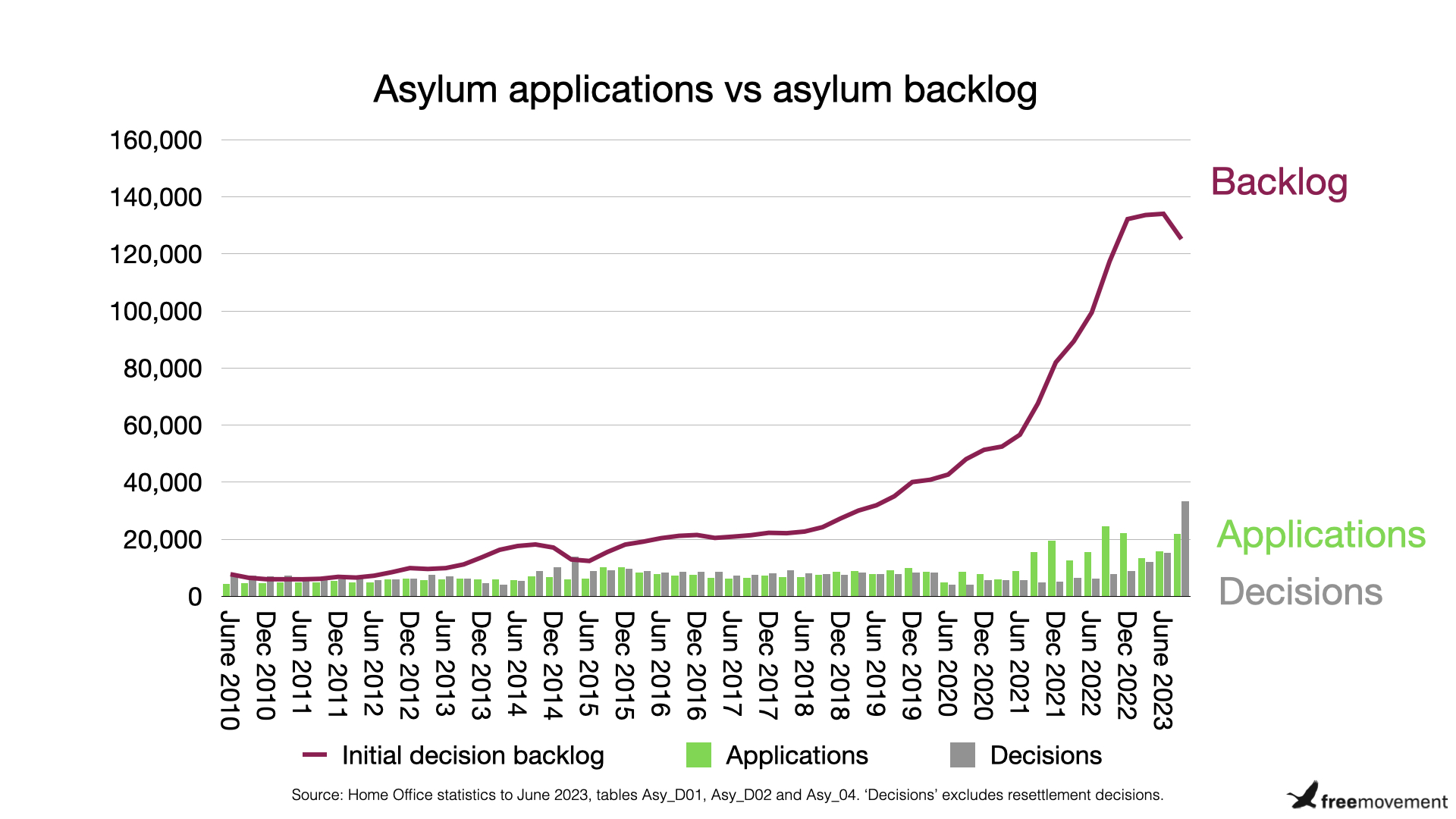
But what caused it to grow in the first place, and how can the government avoid that happening again?
Causes of the asylum backlog
We can see the root cause of the current asylum backlog lies back in 2018, when the percentage of asylum cases decided within six months suddenly plummeted.

There are now tens of thousands of refugees who have been waiting for longer than a year for an initial decision. This is really expensive because they are not allowed to work, and so have to be supported by the government. Because the backlog was allowed to grow, the Home Office ran out of ordinary asylum accommodation long ago and has had to resort to using hotels. The international aid budget has been plundered in order to fund this. Immigration fees have been ratcheted up yet again in order to plug the hole in the Home Office budget, forcing migrants who enter lawfully to pay for those who enter irregularly.
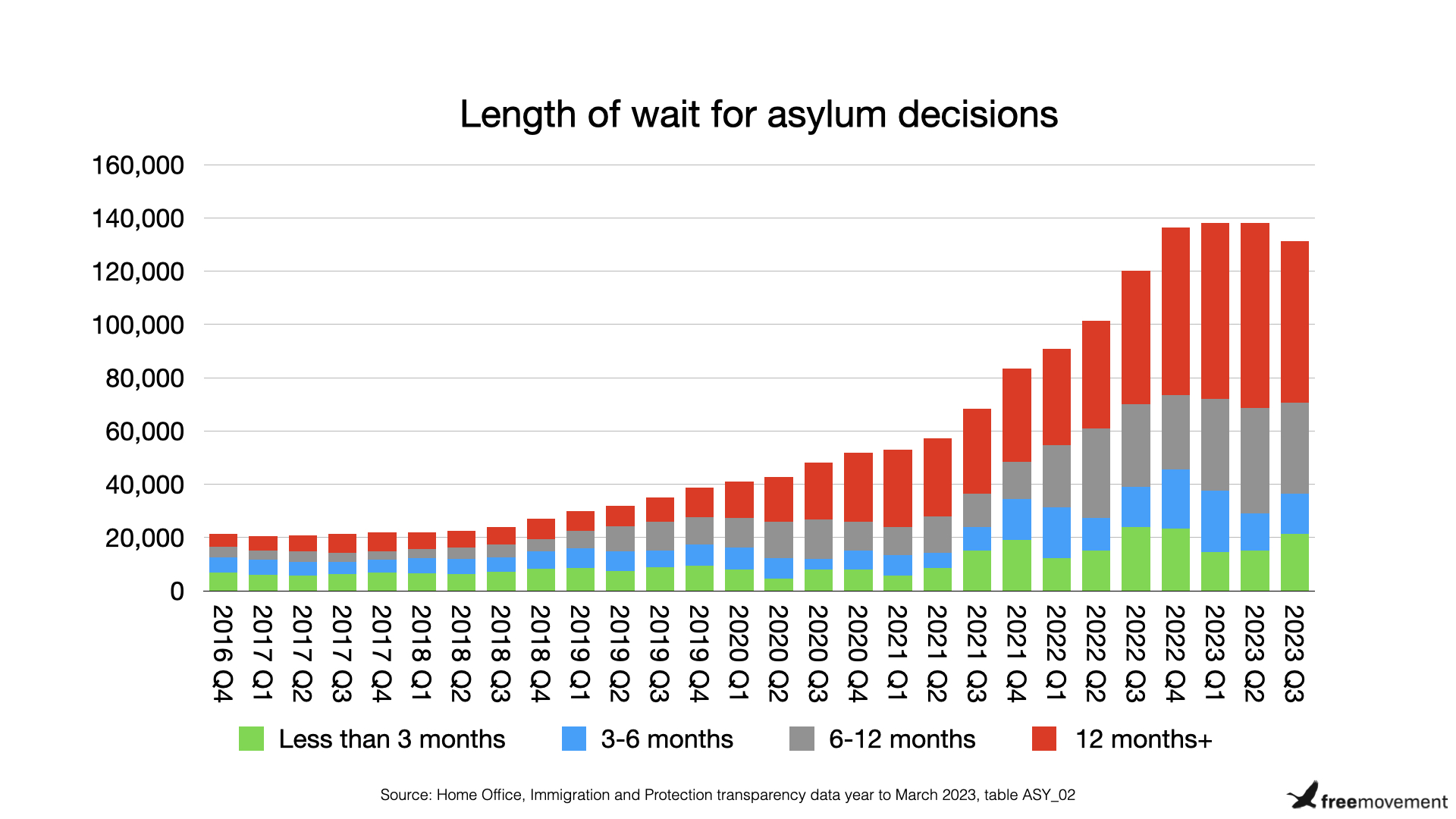
To deal with the backlog, the government decided to recruit more officials to decide asylum claims. Braverman, during her second stint as Home Secretary, said she planned to have 1,300 caseworkers in place by March 2023, a target she managed to hit. Sunak then pledged in December 2022 to double the number then in place, which would mean reaching a total 2,400 caseworkers. That number was hit in August 2023.
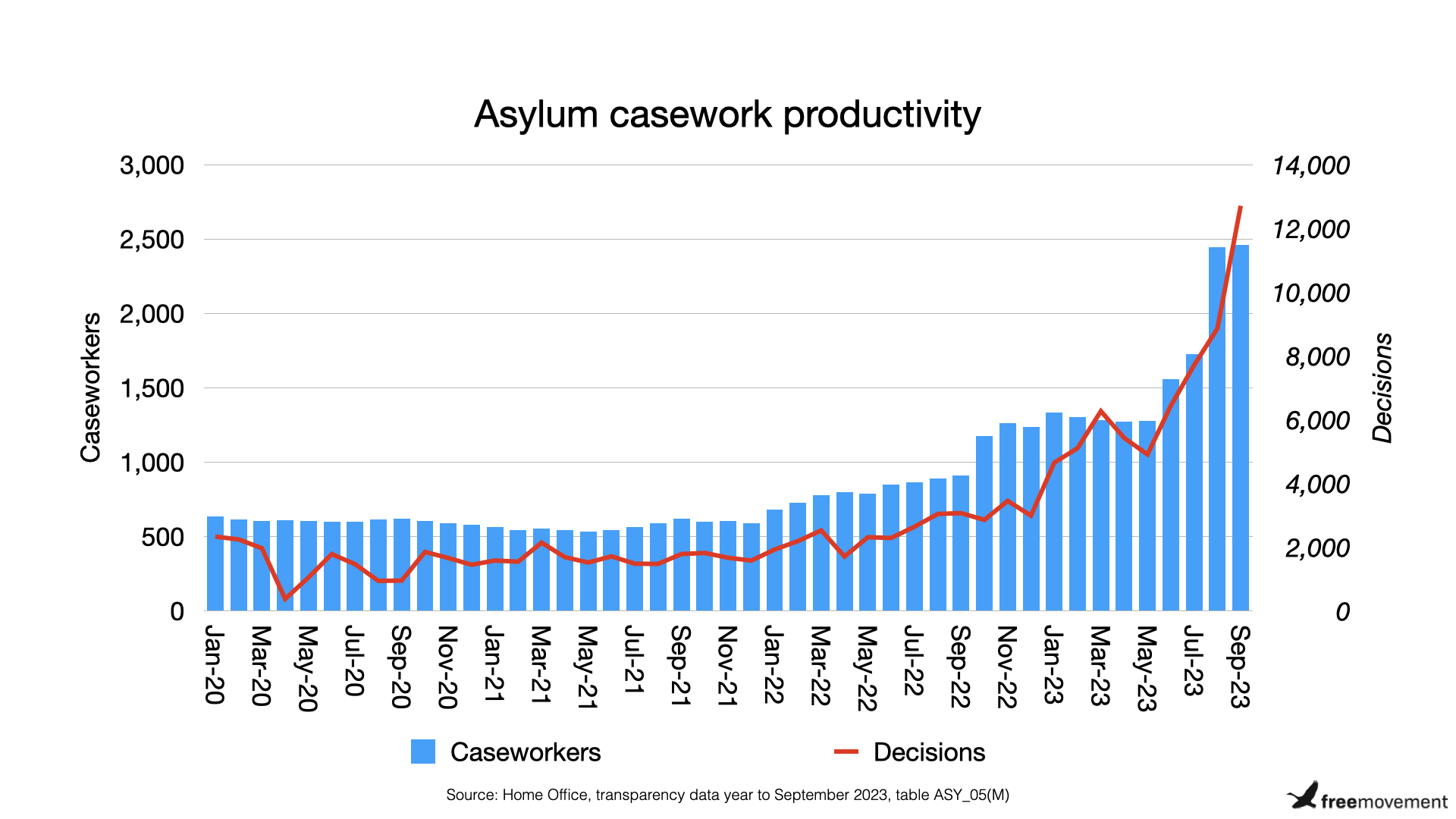
We’d expect there to be a lag between the recruitment of new caseworkers and an increase in decision making. The number of decisions has finally started to rise rapidly, which is finally starting to reduce the backlog.
The number of decisions is likely to go up even further in the next few months as the newly recruited caseworkers establish themselves. However, it cannot be sustained at very high numbers. Many of the decisions at the moment are being made without conducting an interview. We can see from the transparency data that 12,711 decisions were taken in September 2023 but only 7,688 interviews. Once the caseworkers run out of withdrawals and cases that can be resolved with no interview, the number of decisions will start to come down again somewhat.
Whether quality can be maintained is unclear. The Home Office cleared out its experienced asylum officials and has had to recruit rookies. The analogy that comes to mind is with policing; around 20,000 police officers were cut in the austerity years after 2010. The government then announced it would recruit new police officers. 20,000 of them, as it happens. But they are not like-for-like replacements. They are inexperienced rookies who require training. They are less productive and need to learn the ropes.
This is anecdotal, but even with my very small case load as a barrister I have seen two recent asylum decisions that surprised me. The Home Office’s own country information had been overlooked. All I really had to do at appeal was point to that information and the appeals were allowed. If those sorts of errors are occurring at scale and lots of unnecessary appeals are having to be lodged, that is going to induce a significant hangover once the celebrations at the Home Office are over. As we’ll see, lots of appeals is one of the problems looming ahead for the government.
Problems ahead
The number of asylum decisions soared in the third quarter of 2023 to an astonishing 29,000 proper decisions plus a further 4,600 withdrawals of asylum claims. 23,000 decisions were grants of asylum and 6,000 were refusals. This rapid increase in decisions means there are significant new problems looming ahead in the asylum system:
- What happens to the person behind withdrawals of asylum claims? Most of them remain in the country.
- What happens to the 26,000 newly recognised refugees? They get very short notice before they are evicted from asylum accommodation, which is insufficient time to find a job or accommodation, so they end up homeless and supported by their local authority.
- What happens to the 6,000 refused asylum seekers? They lodge appeals, which must then be processed. Waiting times were already approaching two years even before this rapid increase in the number of refusals. They must be supported by the Home Office during that time.
- What happens to failed asylum seekers at the end of the process? Very few are removed.
Let’s consider each of these in a bit more detail.
Are asylum withdrawals really a “decision”?
Since the start of 2023 there has been a huge increase in withdrawals of asylum claims, mainly by Albanian nationals. For example, of 6,068 asylum withdrawals in the first quarter of 2023, 4,386 of them — almost three quarters — were by Albanians.

The spike in resettlement cases in 2021 Q3 represents the Afghan evacuation. You can see for yourself how refugee resettlement work has fallen off since then.
A National Audit Office report in June 2023 revealed that many of these ‘withdrawals’ were actually what lawyers call non-compliance refusals: the asylum seeker failed to return a form on time, did not turn up to an appointment or something like that. Some asylum seekers may genuinely have deliberately disappeared. But experience suggests the Home Office is bad at logging changes of address, posts things to the wrong address anyway and that a certain proportion of these decisions will turn out to be wrong.
This creates a significant long term problem. Many of those treated as ‘withdrawn’ will still be in the UK and will resurface. They may lodge a judicial review of the non-compliance refusal if they think it was a mistake by the Home Office or otherwise will renew their asylum claim or make a new one. They will become complex cases and will take additional resources to process. The Home Office may be making more work for itself in the long run by trying to hit its short-term targets. This would be entirely typical behaviour by the department.
To illustrate the point, consider the number of Albanians who arrived in 2022 and what happened to them.
We know that around 13,000 Albanians arrived in just a few months over the course of 2022, the vast majority in small boats. Just over 10,000 of them made asylum claims. Since then, there have been 8,745 withdrawn Albanian asylum claims. Only 2,716 Albanians made voluntary departures since the start of 2023, though. A further 1,918 were forcibly returned, making a total of 4,634 Albanians who made enforced or voluntary departures since the start of 2023.
We can therefore see that many of those 13,000 Albanians remain in the United Kingdom, including those that made then withdrew asylum claims. They will need to be dealt with at some point.
Their case papers may have been taken off the books and out of the backlog but the actual human beings behind those cases have not disappeared.
What happens to all the newly recognised refugees?
An amazing 23,000 grants of asylum were made between June and September 2023. All of those newly recognised refugees moved from being supported by the Home Office to either standing on their own two feet or being supported by their local authority. Or they fell through the gap and ended up homeless.
After several years of enforced idleness, it is no surprise if only a small percentage manage to find a job in the short space of time the Home Office gives them between issuing their new immigration papers and evicting them from their asylum accommodation.
Sonia has written about this on Free Movement before: the Home Office has quietly reneged on a commitment to give refugees 28 days between issuing their immigration papers and evicting them from their asylum accommodation. Sometimes they are given just days. This makes it impossible to find a job and accommodation and it also makes it very hard to get support from the relevant local authority. As a result, local authorities are finding themselves having to accommodate thousands of refugees at basically no notice.
Some idiots will claim that refugees becoming homeless just goes to show how they are a drain on public resources. If we keep them waiting for years in remote locations, prevent them from working during that time and do everything in our power to prevent them integrating and then give them virtually no notice they are to be granted status and evicted from their accommodation, of course they are going to struggle even more than they might have otherwise.
Local authorities need urgent funding. Central government should allow refugees to find jobs if they’ve been waiting for longer than six months, given them a longer notice period before evicting them from asylum accommodation and offer an integration package, for example including language and career training.

There’s lots wrong with our asylum, immigration and citizenship laws. If you want to be properly informed, check out my book Welcome to Britain, now available in paperback.
Asylum appeals incoming
In the year ended September 2023, 75% of initial asylum decisions by the Home Office were grants of protection. As a percentage, that is an historic high not seen since since the 1980s, when there were far fewer asylum claims being made.

However, because of the sheer number of decisions being made, there are also now a lot of asylum seekers being refused asylum: 5,934 in the last quarter. Many will lodge appeals.
Further, we can expect the percentage asylum grant rate to fall in the near future and the number of asylum refusals to increase further. The newly recruited Home Office caseworkers are working their way through the high grant rate nationalities. Soon they will start making a lot of decisions on lower grant rate nationalities. The overall success rate will fall. When that starts to happen, the number of asylum appeals being lodged will increase significantly.
We might expect the appeal success rate to fall somewhat as the initial application success rises but there is no evidence of that happening yet.
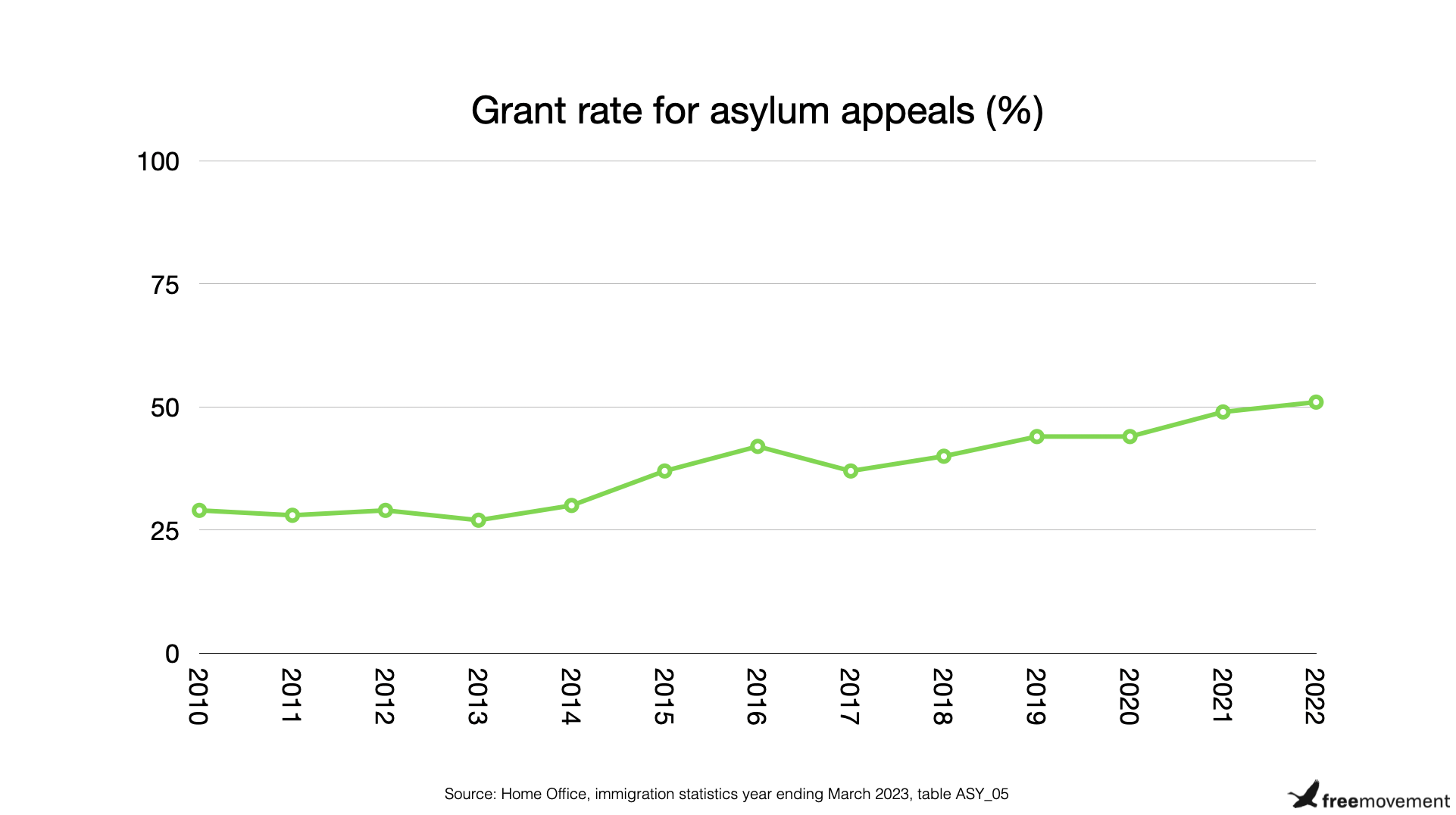
The asylum application backlog is shrinking. But the appeal backlog is growing.
The average time it takes for the First-tier Tribunal to decide an asylum case was 82 weeks in the period April to June 2023. This is up from 29 weeks prior to the pandemic. It was only 48 weeks as recently as 2021, so this looks like a pretty serious problem at the tribunal. Given that it is well known that there is a huge asylum backlog and that the Home Office is increasing the number of asylum decisions made, it was inevitable that the asylum caseload at the tribunal would increase. It seems this has not been matched by increased resources for appeals.
There is a further problem which exacerbates the situation: there are no lawyers left. That’s because legal aid rates are so low that lawyers cannot afford to do the work any more. This may well be a cause for celebration for some, but it risks serious unfairness and causes significant problems to the tribunal system. Already, even before the increase in the number of appeals being lodged, around half of asylum seekers were unable to find a legal aid lawyer. That proportion is going to fall. We don’t grow on trees and even if funding were improved it would still take time to expand the pool of available legal aid lawyers.
The lack of lawyers means that many asylum seekers will go unrepresented. As well as being unfair and risking bad outcomes, including return of refugees to situations of persecution, it builds in additional delays and will make it much harder to reduce the appeal backlog. It takes a lot longer for judges to deal with appeals where there is no lawyer involved.
Refusal ≠ removal
Very few asylum seekers have been removed or voluntarily departed from the UK in recent years. This may be in part because there have been fewer failed asylum seekers to remove because of the comparatively low number of claims, the high grant rate and a lower volume of decisions. However, the long term trend looks a lot like diminished state capacity to enforce or encourage departure of failed asylum seekers.
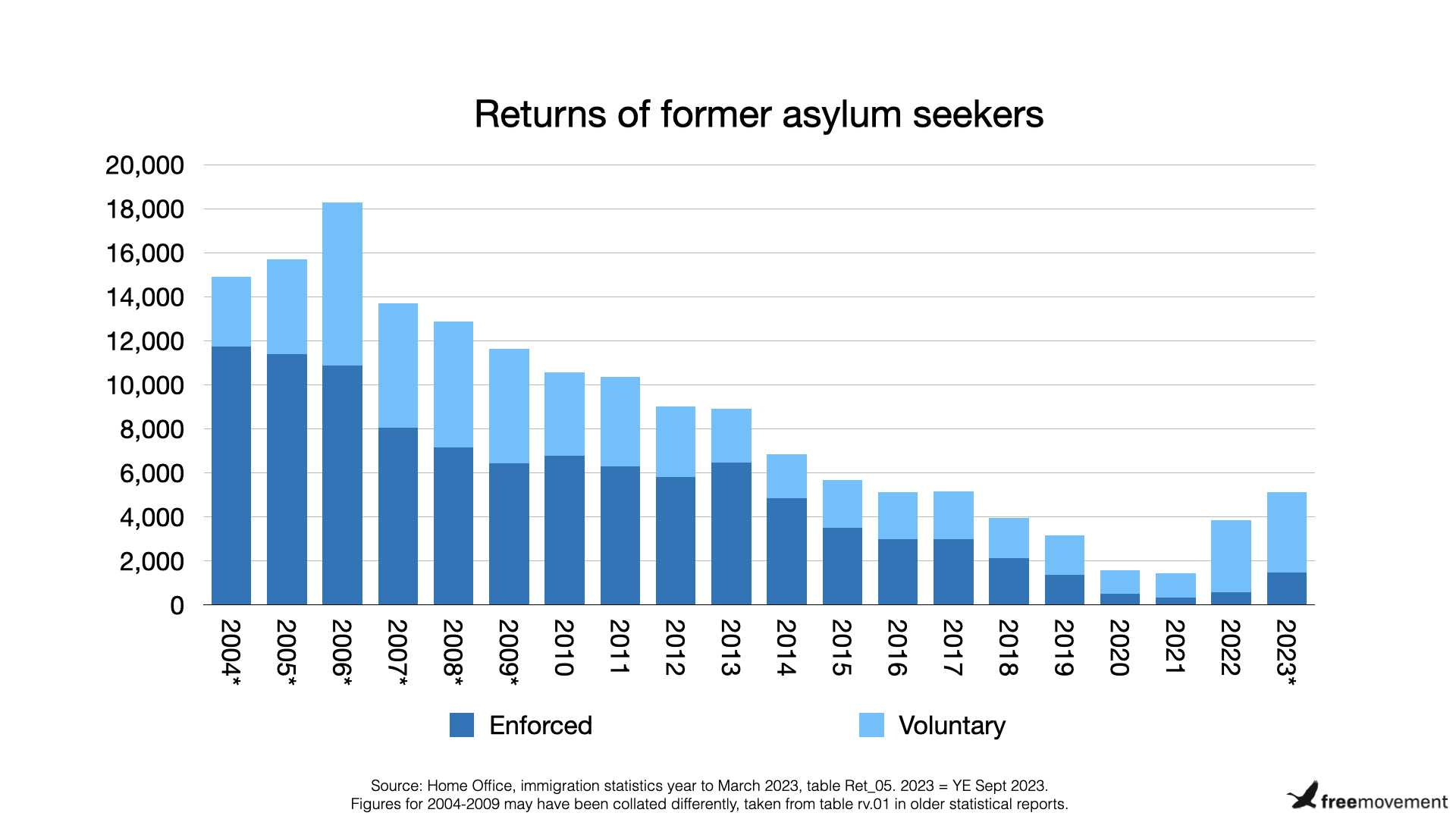
There were just 336 enforced asylum returns in the whole of 2021 and 580 in 2022. The number has increased to 1,468 so far in 2023. The vast majority were Albanian, however: 1,100 of those removals. Albanians also made up just under half of all voluntary departures.

There are only a limited number of Albanians to depart from the United Kingdom given that they stopped arriving in significant numbers in late 2022. Once they are taken out of the figures, we can see that very few failed asylum seekers are generally removed.
During the same period (i.e. since the start of 2023), there were a total of 10,970 asylum refusals. Of course, removals are unlikely to occur straightaway following refusal, not least because a refused asylum seeker has a right of appeal. There were 5,685 asylum refusals in 2022 and 5,117 in 2021.
In total, there have been just over 49,000 asylum refusals in the last five years.
In the same time, there have been just over 13,000 enforced and voluntary returns.
The reality is that even those who lose their asylum cases — a relatively small minority at the moment, given the rise in the grant rate — are likely to remain in the United Kingdom in the long term. No government has been willing to engage with this policy issue since 2010.
Immigration detention
Use of immigration detention has decreased in recent years. A the same time, the percentage of those experiencing immigration detention who are asylum seekers has increased markedly.
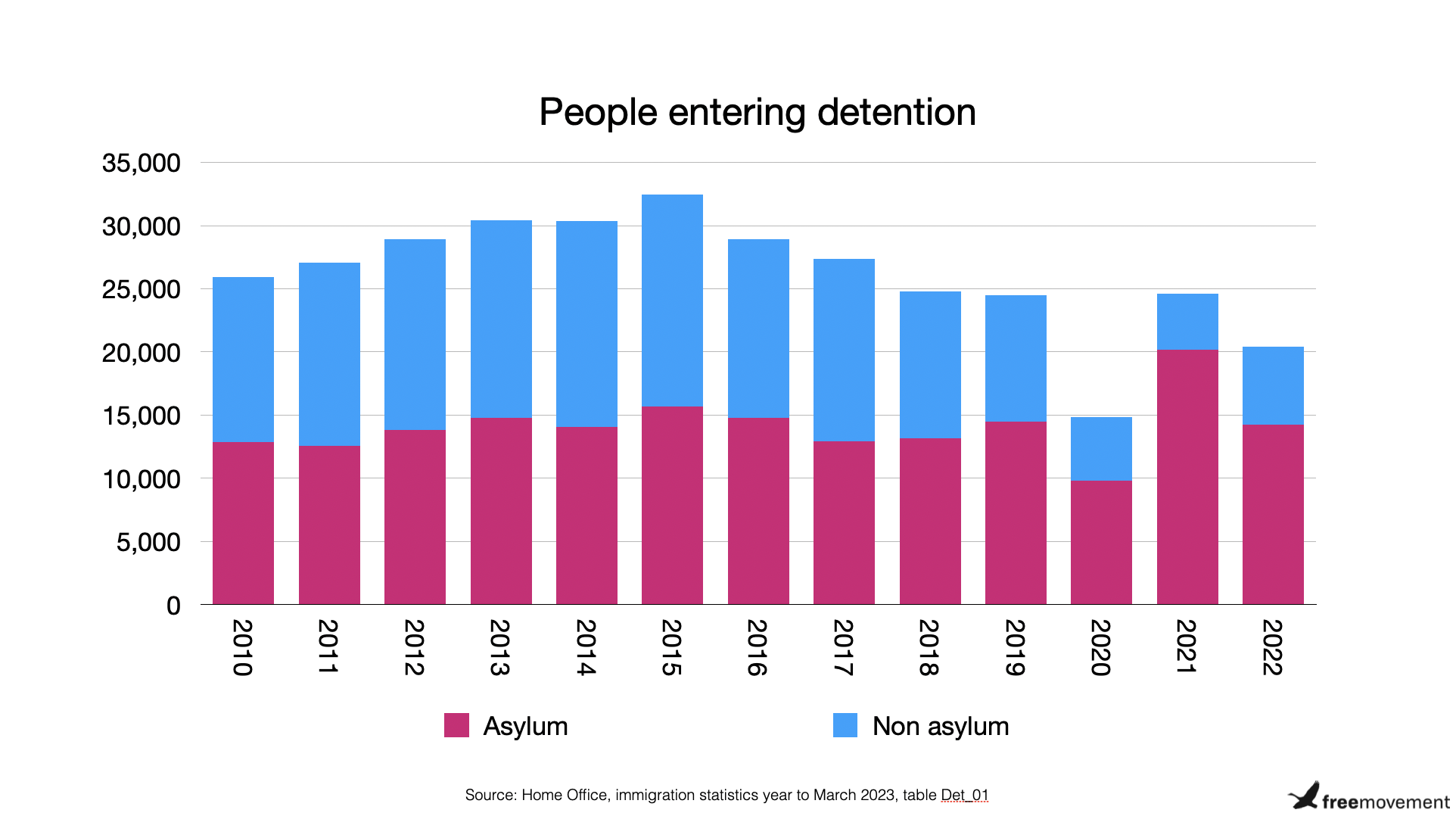
These figures do not include those detained at the de facto detention camps at Penally and Napier barracks or the barge, from which asylum seekers were allegedly free to come and go.
Immigration detention is supposed to be for the purpose of removing those with no permission to remain in the United Kingdom. Immigration detention centres are formally called ‘removal’ centres. However, the number of detainees leaving detention to be removed from the country has fallen drastically since 2010. The majority are now released into the community.
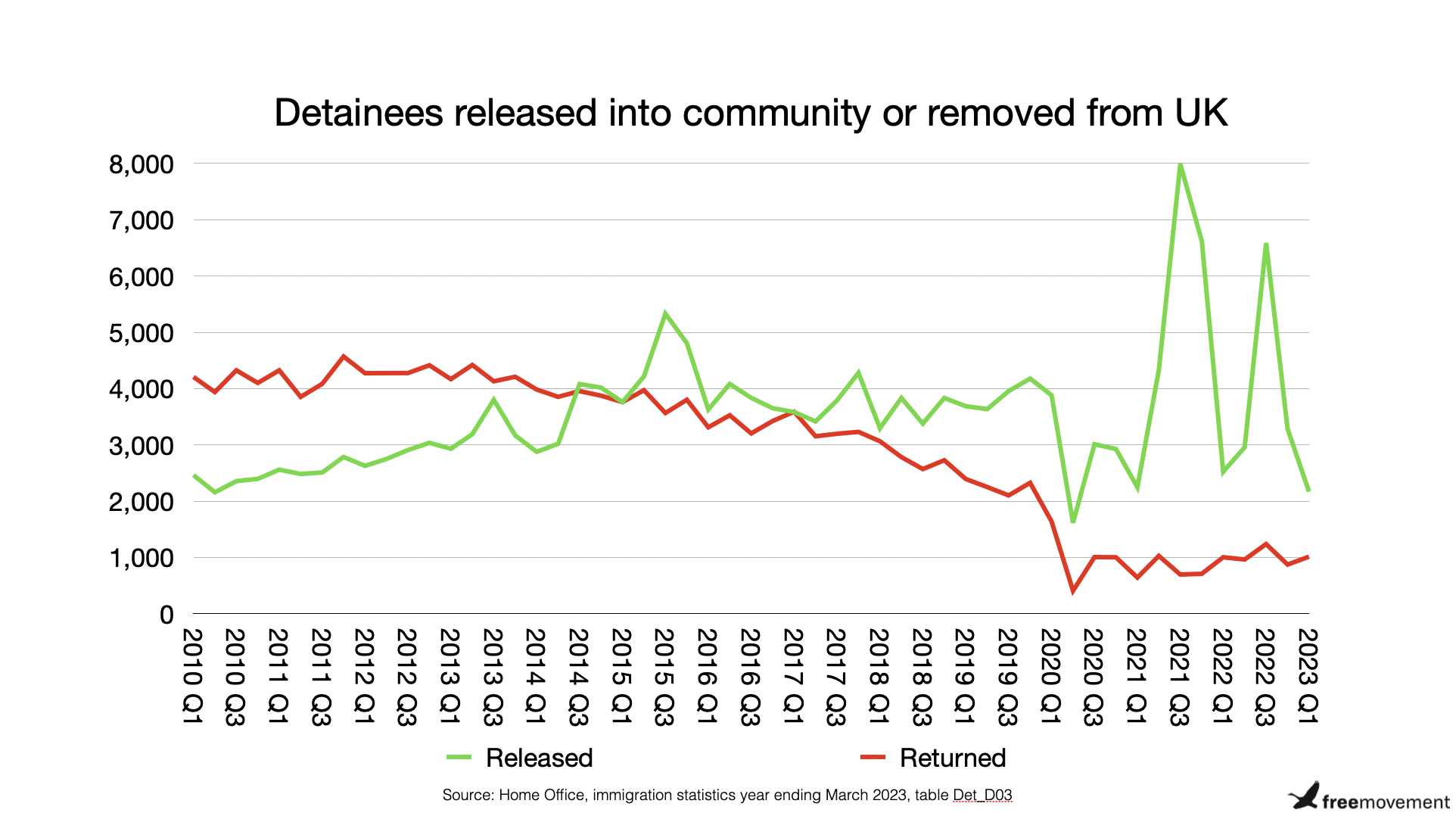
This calls into question whether a decision to detain these people was the right one. The cost of holding a person in immigration detention is around £90 per day.
Substantial numbers of people experience fairly short term detention and some experience prolonged detention.
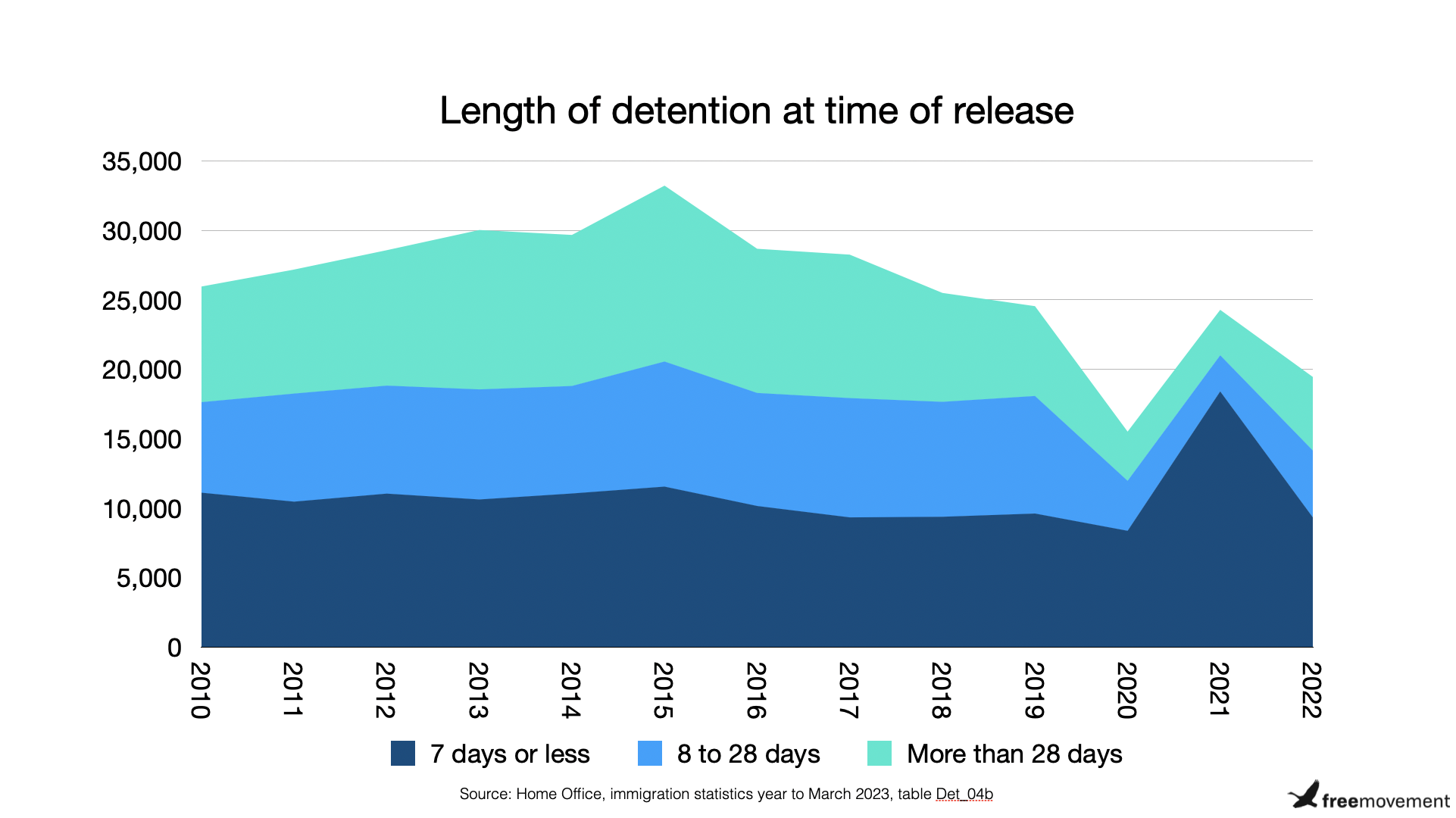
The percentage of people held in short term detention increased markedly in 2021 and then fell back again in 2022. It seems reasonable to assume many of these individuals were asylum seekers given that the number of asylum seekers experiencing detention increased at the same time (see above). Their detention certainly does not seem to have led to faster decisions or to more removals so, again, the purpose of detaining them is unclear.
The big story with immigration detention is that capacity is very limited compared to the number of failed asylum seekers, particularly bearing in mind that detention space is also needed for foreign national offenders, overstayers and refused entrants. Unless a government is willing to build extensive (and expensive) prison camps and then also use them — meaning long term detention of some, dawn raids, self harm, suicides other manifestations or consequences of that degree of state coercion, the number of detention spaces is never likely to be sufficient to remove all those the government in theory wishes to remove.
Detention is therefore likely to be arbitrary, in the sense that it is a matter of good or bad luck whether any given individual in the “pool” of potential removees is actually detained and removed. Effectively, all it is being used for is to punish a small sample of a wider class of person.
If detention is to be used on a more rational basis, the issues are around how Home Office resources are organised and allocated, what groups if any are targeted for removal and what safeguards if any are used to prevent discrimination, abuse and the selection of ‘soft’ targets.
For example, detaining for a prolonged period a foreign national offender who is never likely to be removed means that one detention space is “blocked” for a substantial period. Its function is to give the department short term political cover but it comes at the cost of not being able to use that detention space for other purposes. It is obviously bad for the detainee, it is pointless aside from the political cover it provides and it is actively harmful to wider departmental objectives.
The drift in recent years away from the use of detention for the purpose of removal is likely to be the result of a lack of focus on these issues.
Resettlement and safe and legal routes
The government likes to talk about safe and legal routes to reach the United Kingdom. The reality is that unless you are Afghan, Ukrainian or from Hong Kong there are no such routes to speak of.
In the year ended September 2023, 1,100 refugees were resettled through Afghan schemes and just 700 through the wider UK resettlement scheme.
There is no queue to jump. It is not possible for a person to apply for the general resettlement scheme. Eligibility is determined by UNHCR. Essentially, a person has to be a registered refugee in a UNHCR administered refugee camp and hope they are picked for resettlement. If they are selected, they have no say over the country to which they are resettled. It might be the UK but it might be Australia, Canada, the United States or other participating countries.
The good news is that as 30 June 2023 a total of 179,500 Ukrainians had entered the UK under the two visa routes opened for them. Some will also have returned home in that time. You can see the latest statistics yourself here. Many more visas than that had been issued but not yet used. UNHCR have put together data on which countries are hosting how many refugees. By way of comparison, Poland is estimated to be hosting 992,670, Germany over 1 million, Czech Republic 341,745, Bulgaria 160,575, Spain 182,600, Italy 175,105 and France 70,570.
A total of 184,700 visas (in country and out of country combined) have been granted to British Nationals (Overseas) from Hong Kong and their dependants. While this can be classed as a resettlement or protection route, the vast majority are not refugees according to the legal definition of a refugee and many would reject that label.
What can be done?
The United Kingdom asylum system is indeed broken. It is, to a very significant extent, Priti Patel who broke it. It was on her watch that small boat crossings soared and so did the asylum backlog. The asylum backlog was already growing when she took over but she has allowed it to triple further on her watch. Schemes like a new 10 year route for refugees, recently abandoned, and increasing the Home Office resources funnelled into pointless age disputes made the situation worse not better.
The good news for James Cleverly — and perhaps a new Home Secretary after an upcoming election — is that the situation seems to have stabilised. The asylum backlog is finally coming down. But, as we have seen, there are still significant issues to be addressed, caused in large part by the aftermath of that backlog.
Ministers and managers need to think about prioritising resources. This has to mean doing less of some things in order to do more of others. Why not just grant recognised refugees immediate settlement, for example, rather than conducting a pointless review of their status after five years?
The asylum system is not beyond repair. It requires competent focus on the boring day job instead of being distracted by pointless or even counterproductive gimmicks. The Illegal Migration Act would make things worse if it were implemented, as I argued in a previous post. The idea that the Home Office is going to remove all of the 84,000 people they expect to be in the new backlog by the end of 2023 plus all those who newly arrive is preposterous. They will either have to be supported by the state in the meantime or they will disappear, given they will no longer have any prospect of ever been granted asylum and therefore no incentive to remain in contact with the Home Office.
Recent changes show that positive asylum decisions can be made much, much faster than in the past, which is great news for everyone. It’s just not that hard to grant asylum to an Afghan, Eritrean, Sudanese or Syrian given they have a 98% grant rate or more. All officials need to do is to establish nationality, conduct security checks and issue the grant letter. The Home Office initially messed even that up by issuing long, complex forms in English only and failing to fund any help to fill them in. Absurdly, after we warned them it was a bad idea, they decided to blame the lawyers. Again. Officials can and should learn from these mistakes.
The treatment of refugees in the backlog and when they receive a positive decision should be reviewed. Allowing asylum seekers to work after six months waiting for a decision would mean far fewer becoming homeless when they are granted asylum, for example. Even just giving them a bit more time between receiving their immigration papers and evicting them might reduce the number who end up homeless. A support and welcome package for newly recognised refugees should be introduced, which would save money in the long run.
More resources urgently need to be challenged into asylum appeals and legal aid. The appeal success rate remains very high, suggesting that many unnecessary appeals are being lodged. Proper, realistic reviews of pending cases might reduce the appeals backlog and save considerable time and money. Monitoring of officials who wrongly refuse applications or reject an appeal review should be introduced.
The department’s approach to detention and removal needs reviewing. What is detention really for? If very few failed asylum seekers can be removed then does the department want to focus resources on particular groups and what should happen to the rest? Is it acceptable to simply add them to the unauthorised resident population and allow them to regularise only after they have children or live below the radar for 20 years?
If we step back and look at the fundamental change in the asylum grant rate combined with the low number of asylum removals and departures, we can see that it is time to scrap the deterrent policies established in the 1990s and early 2000s, when far fewer asylum claims succeeded. Michael Howard, then Home Secretary, told Parliament in 1995 that only 4% of asylum succeeded as did a further 4% of appeals. The ban on the right to work, the destitution-level support offered instead, the squalid accommodation and camps and the highly bureaucratic, faceless asylum process all absorb vast Home Office resources to administer. These policies, which belong to a bygone age, deter no-one. They merely serve to punish genuine refugees who will ultimately get to stay in the United Kingdom in the long term. It is their interests and ours to help them integrate as soon as possible rather than forcing them into this demeaning purgatory first.
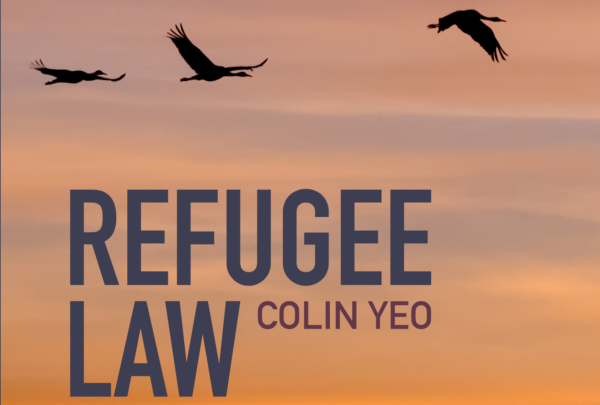
Want to really get to grips with refugee law? Concise and readable, Colin’s textbook walks you through everything from well-founded fear to refoulement.
[ad_2]
Source link
Related posts:











